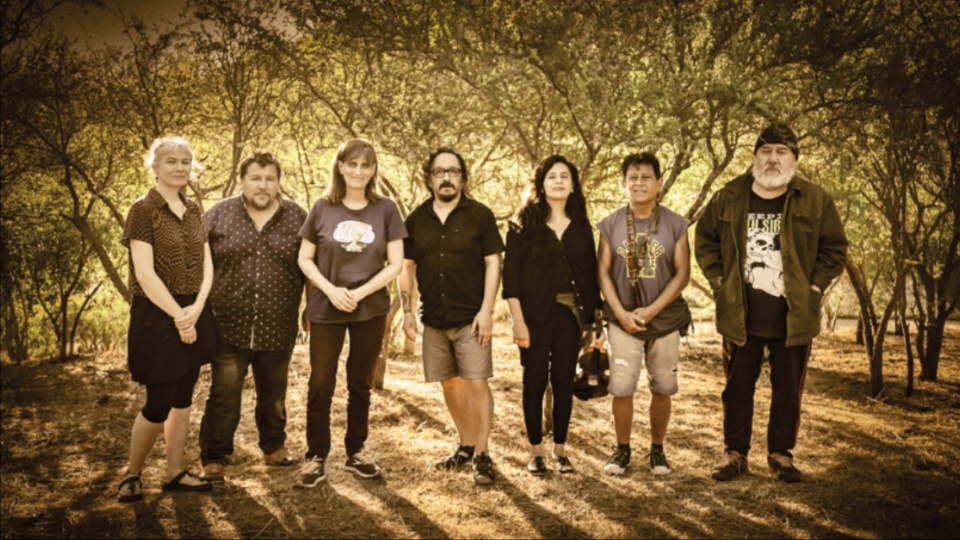
Susan Alcorn has carved out a multi-sided musical career for herself focusing on her main instrument, the pedal steel guitar. Based on her previous albums, it would appear that she is capable of almost anything. Perhaps the single word, though so limiting in her case that maybe it shouldn’t even be used, is “jazz” artist.
Her latest album, released in November 2023, is rooted in her experiences, travels and study in Chile 20 years ago, when she learned about the country’s tragic and heroic history, meeting survivors of the Pinochet regime and hearing the music of the land. She returned in 2022 to record Canto, going to the remote coastal mountain town of María Pinto to gather her musicians and lay down her tracks.
Six songs comprise the 44-minute album, five of them her own compositions, though with many echoes of Latin America’s popular nueva canción movement. The sixth and last song is the famous Chilean troubadour Víctor Jara’s anti-imperialist anthem, “El derecho de vivir en paz” (The Right to Live in Peace). It never ceases to amaze that such a simple, basic right is so flagrantly, so violently insulted every day of every year. Jara’s song, I’m afraid, will never be out of date.
Alcorn’s band, her “Septeto del Sur” (Southern Septet), includes herself on pedal steel guitar, Luis “ToTo” Alvarez on guitar, Claudio “Pájaro” Araya on drums and cuatro, Francisco “Pancho” Araya on charango, Rodrigo Bobadilla on flute, quena, zampoña and vocals, Amanda Irarrazábal on double bass and vocals, and Danka Villanueva on violin and vocals.
With such forces, all eager to contribute their voices, instrumental timbres and potential to the mix, Alcorn has produced a sonic ambience that combines elements of classical training with the Chilean folk tradition, with plenty of room to spare for freestyle improvisation that never overstays its welcome.
The first cut, “Suite Para Todos” (Suite for Everyone) is an impressionistic meditation freely extrapolating on Debussy’s whole note scale, with an imagined seascape within hearing distance, flights of birds represented by indigenous flutes.
The next three songs are Cantos, perhaps best translated as “chants” or “cries from the heart.” Canto I is titled “¿Dónde Están?” (Where Are They?). “They,” anyone in Latin America will tell you, are the desaparecidos, the disappeared, activists, peasants, workers, students, swept up by the authorities and never to be seen again. It’s based on a sonorous, familiar-sounding folk-like melody and then disperses into disconnected episodes, each yielding up a new musical horizon. I imagined myself in a high, silent glider plane slowly circumnavigating the globe on a voyage of sonorities, revealing all the mystery and magic of the Earth’s multitudes of terrain. Might somebody’s son, or sister or lover have been dropped into some wilderness from a helicopter and survived there?
In Canto II, “Presente: Sueño de Luna Azul” (Present: Dream of a Blue Moon), a steady low drumbeat anchors this experimental, baroque fantasy, a slow little dreamlike drama. Just what might go through your brain if you ever stood out in a quiet, deserted open space far from civilization viewing a strange, somehow not surprising but portentous aquamarine moon, the occasional shooting star streaming by, descending to its mystical cosmic fate. Here the first vocals appear on the album, more vocalization than verbal.
Canto III is called “Lukax,” named for a Chilean musician and former political prisoner Lukax Santana. It’s a easy dance, a sad waltz, perhaps, distorted by breathy Andean flutes reaching toward a kind of improvisatory anarchy for the whole ensemble that finally returns to melodic sanity.
The fifth cut on the album is in honor of “Mercedes Sosa,” one of the pioneers of the nueva canción movement. This tune has a frankly unapologetic waltz for its opening statement that then, in jazz mode, dissolves into its component parts with the different instruments entering with their own commentary. One can picture the spirit of the world-famous singer and songwriter smiling from above, seeming to say, “Go on! I like it!” The waltz returns as palm court salon music for the nueva canción generation.
Finally, one of Víctor Jara’s most influential songs, performed here by the two female vocalists in a contemporary rendition suited to Alcorn’s musical proclivities.
The album itself has the barest possible information on it, mostly just the necessary credits. It contains no “artist statement” or grandiose, gestural call to action. Canto is not your typical Latin American dance album with propulsive, danceable rhythms to get your feet and hips moving. No, it’s more meditative, joyful even in its solemnity, reminding us of the ancient Orpheus lesson that when life hands us great sorrow, it is our duty as artists—and activists—to convert that pain into poetic beauty and healing contentment.
A YouTube of Canto can be viewed here. Further information on Canto can be accessed here.
Susan Alcorn and Septeto del Sur
Canto
Relative Pitch Records, 2023
RPR1170
We hope you appreciated this article. At People’s World, we believe news and information should be free and accessible to all, but we need your help. Our journalism is free of corporate influence and paywalls because we are totally reader-supported. Only you, our readers and supporters, make this possible. If you enjoy reading People’s World and the stories we bring you, please support our work by donating or becoming a monthly sustainer today. Thank you!












Comments